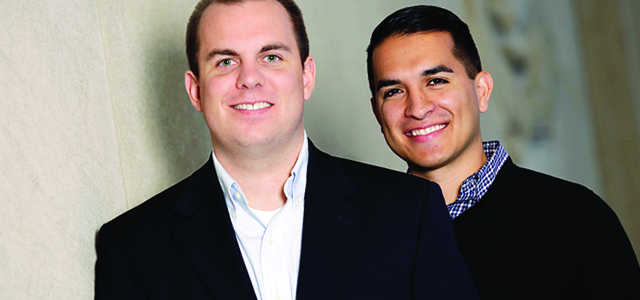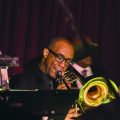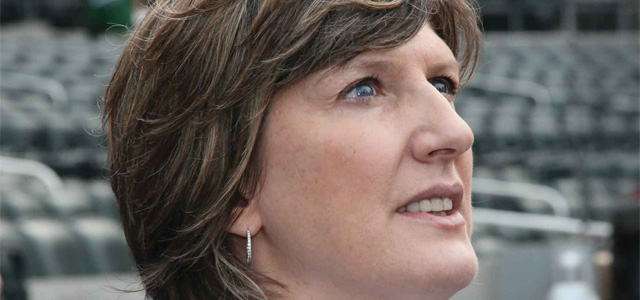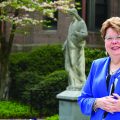Marcos Mendez ‘06 and Kevin Losch ’06 share an unbreakable bond, formed out of one remarkable act of generosity.
When Kevin Losch ’06 needed a kidney transplant in 2013, he was surprised when he couldn’t find a donor match among his large extended family.
Instead, he found a donor within the Seton Hall family, a friend he met in 2002 during orientation at the Stillman School of Business: Marcos Mendez ’06.
 Mendez and Losch started out by sharing a bond based on similar temperaments and a passion for sports. It developed and deepened over time. They became friends in Boland Hall, played intramural basketball together, roomed with each other senior year and served in each other’s weddings.
Mendez and Losch started out by sharing a bond based on similar temperaments and a passion for sports. It developed and deepened over time. They became friends in Boland Hall, played intramural basketball together, roomed with each other senior year and served in each other’s weddings.
Now they share an organ.
Mendez’s action marks a very rare friendship, says Dr. Shamkant Mulgaonkar, the physician who oversaw their transplant procedure at Saint Barnabas Medical Center in Livingston, N.J. “It’s a no-brainer for a mother or father to volunteer for a child. Anyone else coming forward is a very special person.”
After five years without a physical, Losch reported for a medical exam in December 2012, about four months before he was to marry Kendra Benitez. Benitez, an occupational therapist at the Children’s Specialized Hospital in New Brunswick, N.J., had been urging him to get checked out.
Losch walked out of the exam feeling healthy, but a blood test revealed disturbing news: The level of his creatinine (a natural byproduct of muscle metabolism removed from the body by the kidneys) had spiked to 3.7 milligrams per deciliter; it should have been about 1.0. “He said I really needed to get this checked out,” Losch remembers.
A snowstorm in February cancelled a follow-up with a kidney specialist, and Losch missed another appointment offered just three days before his wedding. “I wasn’t having any real symptoms,” he says.
On his honeymoon in Hawaii, however, Losch says he “started having all the symptoms of kidney failure,” including loss of appetite and low energy. After he got home, the disease markers multiplied. Swollen ankles, vomiting, intermittent crippling headaches and weight loss of nearly 20 pounds afflicted him. He still thought “this is not a big deal.”
When Losch arrived in June 2013 for the much-delayed appointment, he got what he calls a two-sided diagnosis from the kidney specialist. “The good news was that I didn’t have polycystic kidney disease.’ [His mother suffered from that disease, which involves cysts on the kidney.]
“The bad news was that I had something else,” Losch says.
That something else was IgA nephropathy, or Berger’s disease. The disease occurs when IgA — a protein antibody that helps the body fight infections — damages the kidneys. IgA deposits can cause severe scarring and kidney failure.
The problem, says Dr. Mulgaonkar, occurs when IgA — “little soldiers called into action in an infection” — attack more than they’re supposed to. This is not uncommon. Mild cases can cause blood in the urine, but the kidneys later clear up. Kidney failure occurs, though, “when the kidneys start to scar down.”
The day Losch was tested, the technician had to make five attempts to get a clear tissue sample from Losch’s battered kidneys. His creatinine level had spiked to 21. Based on a call he got the next morning, where “the doctor told me I was using less than 5 percent of my kidney function,” Losch admitted himself to the hospital that night and later began dialysis, a procedure that involves putting a catheter in the chest connected to a machine that does the work of the kidneys, filtering waste materials from the blood.
When well enough to leave the hospital, Losch began a regimen of four-hour dialysis sessions three days a week in Hoboken, a schedule that played havoc with his job in New York City at Morgan Stanley as a financial adviser to high net-worth clients. He began to consider his options.
A kidney transplant was the only real solution, and Losch thought it “would not be a big deal” to find a donor, typically selected from blood relatives. The youngest of four, he has two older brothers and a sister, in addition to his parents, cousins, aunts and uncles. “As it turned out,” he says, “none of them was a match.”
Two months passed as members of his family were tested but failed to match.
“It wasn’t until August that I sent out an email to Seton Hall friends” in search of possible donors with an O blood type. “It was one of the more awkward things I’ve had to do,” Losch says.
He was hoping to find someone close to the New York area, but none was qualified. Yet within an hour, Mendez responded by iPhone from Houston, in a message that Losch has saved on his computer: “I know it’s long distance but consider me in.”
Mendez may have responded to Losch’s plea with alacrity, but it wasn’t a snap decision, he says. Nor did he listen to anyone who suggested he reconsider. “As it got closer, people started projecting their fears,” Mendez recalls. “But I’d made the decision based on what I felt was the right thing to do. Possible results can’t dictate a decision.”
Meantime, his parents and wife, Jackie (Ochoa ’06), “were nervous,” he admits, “but they knew Kev and never said ‘don’t do it.’”
The two had a lot of history together, starting with their first days at Seton Hall. The week before classes began in 2002, Mendez remembers, he and Losch were part of a discussion group. He noticed they had similar personalities, that they both were “pretty reserved.” They first connected on sports. But more than that, Mendez says, Losch served as an emotional anchor for a young man coming from El Paso, Texas, and encountering culture shock on the East Coast.
“Being away from home, it was nice to have someone show me around the area, invite me over to his parents’ place for Super Bowl parties,” or go to basketball games with tickets purchased by Losch’s father, who “had great seats for us.”
“Kevin always included me in his family,” he explains.
The ties multiplied. Jackie, Mendez’s high school sweetheart, applied to Seton Hall after her sophomore year. Jackie became friends with Kevin, too, and bonded with Kendra when they met.
After graduation, all four ended up as close friends in the New York area, even taking vacations together.
So it was natural that two years after graduation, when Mendez was about to make a momentous decision, he asked Losch for advice.
They were together in October 2009, watching New York battle the Phillies in the World Series. Mendez leaned toward Losch and told him he wanted to propose to Jackie. “But I can’t think of how to do it,” he remembers adding. “I don’t want it to be cheesy. Got any ideas?”
Losch had a winner: ask her on Halloween, on an annual cruise they took with friends around New York harbor.
The occasion turned into an impromptu engagement party and worked so well that in April 2011, Losch became best man at Mendez’s wedding; Kendra was a bridesmaid. Three years later, Mendez and his wife were in the wedding party at the Losch nuptials.
Mendez eventually left New York City after getting promoted in his job at Altria, a large American multinational company, and he began to pursue a master’s degree in business administration at Texas A&M near Houston. But the couples continued to share cross-country time together.
“When I heard he got sick over the summer I started looking into this whole transplant thing,” Mendez says. Though Losch didn’t mention anything, word of his plight came through the wife network.
Before the operation, Jackie Mendez, an events planner, staged a blowout party for him. This one had a kidney theme instead of a Halloween motif.
As Mendez explains, “Everyone wore hospital scrubs. There was a kidney-shaped cake. And people drank shots out of syringes.”
In the operating room, not long after that party, doctors removed one of Mendez’s kidneys in a laparoscopic procedure involving three tiny incisions and blasts of carbon dioxide to spread the surrounding tissues to gain access. Dr. Mulgaonkar notes that within five days, the remaining kidney grows to take up the strain and achieves 85 percent to 90 percent of the capacity of two kidneys. Mendez says he also found out it hurts like heck during those first few days.
Marcos Mendez’s gift to Kevin Losch was no common act. More than 99,000 people awaited a kidney on an organ transplant list last year, according to the Department of Health and Human Services. But there were only 12,000 kidney donors.
What accounts for such selflessness?
“Kevin is a great friend and someone I love,” says Mendez. “I just hope someone would return the favor if I was in Kevin’s situation.”
“Marcos obviously will do anything for you,” says Losch. “He’s everything you want in a friend.”
Dr. Mulgaonkar, whose hospital mixed the two men’s blood weeks before the operations to test for compatibility, may describe it best: “I think they’re absolutely committed to their friendship.”
Bob Gilbert is a writer based in Connecticut.








Wow! That is a pure testament of friendship. I would be glad to donate a kidney as well for a dear friend if it calls to that.